October 28, 2014
by Carole Zangari -
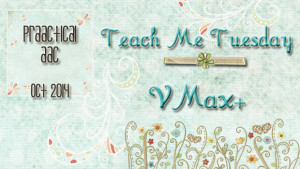
Need to learn more about the VMax+ from DynaVox? Welcome to the V and VMax Video Getting Started with the V and VMax Video V and VMax Basics Video Understanding InterAACt Video V/VMax Quick Start Guide Series 5 User Guide Series 5 Training Manual Series 5 Full Manual InterAACt Guide Where to Go for Help: Search the Knowledge Base, Live Chat, Phone (800-588-4548)
Filed under: PrAACtical Thinking
Tagged With: Dynavox, Teach Me Tuesday, VMax+
October 25, 2014
by Carole Zangari -
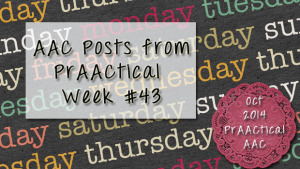
Sunday: Video of the Week – Getting Started with AAC Assessment Tuesday: Teach Me Tuesday – iAssist Communicator Wednesday: Global Day of AAC Thursday: How I Do It by Rachael Langley – PODD in the Classroom: Portable, Wearable, & Comfortable Friday: 5 Things that (Should) Guide SLPs in the Practice of AAC
Filed under: PrAACtical Thinking
October 24, 2014
by Carole Zangari -
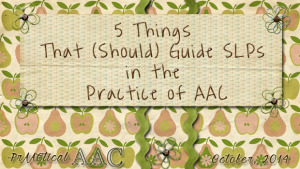
Providing good AAC services is messy stuff. To start with, language therapy can’t be tied up into neat little packages. Add in motor skills, symbolization, perceptual abilities, the technology, and all the rest of it and you can see why SLPs new to AAC get overwhelmed. Here are some resources we turn to when trying to blaze a path to communicative competence with our AAC friends. ASHA’s Roles and Responsibilities of SLPs with Respect to AAC National Joint Committee (NJC) Position Statement on Eligibility to Communication Services Developmental Patterns for Syntax and Morphology Data from a Comprehensive AAC Assessment ASHA Code of Ethics
Filed under: PrAACtical Thinking
October 23, 2014
by Carole Zangari -
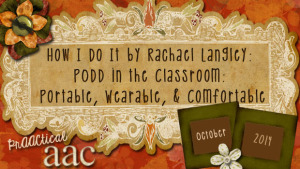
We return to Michigan today to hear more from school-based SLP, Rachael Langley. In this post, Rachael shares some prAACtical thoughts on making PODD books always available for communication. ::::::::::::::::::::::::::::::::::::::::::::::::::::::::::::::::::::::::: The PODD system offers a complete language approach through carefully organized symbol sets. Because the PODD system promotes a language immersion model, there is no pressure on our language-learners reproducing specific words or patterns at a specific rate. The primary requirement is that adults are modeling PODD for our language-learners. In order to be sure that the PODD books were being used throughout the day, the books had to be PORTABLE, WEARABLE, and COMFORTABLE. Forget any of these three features and PODD books are at a high risk of being stuck on a shelf. My new hobby has become collecting other people’s ideas for how to make PODD books comfortable to carry around. I’ll spare you the pictures of my... [Read More...]
Filed under: PrAACtical Thinking
Tagged With: PODD, Rachael Langley
October 22, 2014
by Carole Zangari -

Join the party! Today, people all over the world are celebrating the possibilities of AAC. Judy Bailey has once again taken the lead to promote a variety of activities, Here’s what’s happening. A bit of conversation on the International AAC Awareness Month Facebook Page Discussions on Twitter that include a special hashtag: #AACchat An AAC chat via Skype (connect with Judy Bailey on Skype judy.bailey3) starting at 8 AM today Eastern Daylight Time (USA) Justin Bergers’ internet radio program at http://solaremire.ddns.net:8167/listen.pls
Filed under: PrAACtical Thinking
Tagged With: awareness
October 21, 2014
by Carole Zangari -
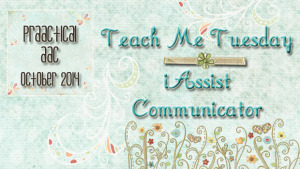
Come along with us to learn more about The Communicator by iAssist. Love seeing options specifically for teens and adults! General Product Information Training Videos Communicator Files and Downloads FAQ Page
Filed under: PrAACtical Thinking
Tagged With: Communicator, iAssist
October 18, 2014
by Carole Zangari -
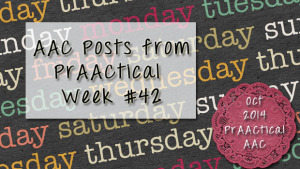
Sunday: Video of the Week – More on Mentoring Tuesday: How We Do It: Tele-AAC with Nerissa Hall and Hillary Johnson Wednesday: Watch It Wednesday: Bob Williams on Celebrating the ADA Thursday: The Faces of AAC: Gretchen and Zach Friday: 5 Things to Do to Help AAC Learners Communicate About Illness or Injury
Filed under: PrAACtical Thinking
October 17, 2014
by Carole Zangari -
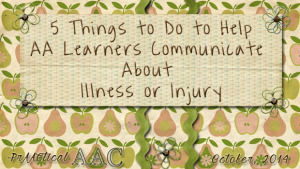
“I don’t want to go now. I’m tired.” “Can you be quiet? I don’t feel well.” “My ear is throbbing.” “I have a such a headache.” “Don’t take me in the car. My stomach’s upset.” Imagine not being able to manage these symptoms or even say these things to get someone to help you. Good SLPs get input from families during the goal-setting process. Often, families indicate that they want their son/daughter to be able to let them know when they are sick or in pain. This makes sense, of course, but it isn’t an easy skill set to build. Here are some things that have worked for us. Make sure the right vocabulary is there: Body parts, feelings, words related to injury or illness, modifiers to tell how much, locatives to tell where. How can we expect AAC learners to communicate when they are unwell if we don’t provide... [Read More...]
Filed under: PrAACtical Thinking
Tagged With: Health, illness, Injury, Medical
October 16, 2014
by Carole Zangari -
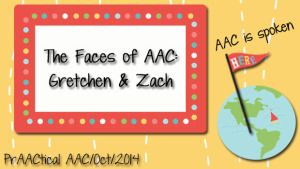
From Bielsko, Poland, to Denver, USA, we are continuing to share the Faces of AAC. Today, we meet SLP Gretchen Storm, who works in the public school system and has a private practice. Gretchen enjoys collaborating with parents, children, teachers, other healthcare providers, siblings and peers in strategies and facilitating communication through speech generating devices. In this post, Gretchen introduces us to Zach. :::::::::::::::::::::::::::::::::::::::::::::::::::::::::: Zach is an 11 year old who uses a Tobii I-12 eye gaze communication device to communicate. He previously used a switch scanning method on a VMax from Dynavox. Zach recently switched to an eye gaze device. Though he loves to use his arms and hands whenever possible, his motor control of them is not ideal for the consistent switch access needed for switch scanning. He was switched to an eye gaze system which could also serve as a switch scanning device if in the future he demonstrates improved... [Read More...]
Filed under: PrAACtical Thinking
Tagged With: AAC Awareness, eye gaze, Faces of AAC, Gretchen Storm
October 15, 2014
by Carole Zangari -
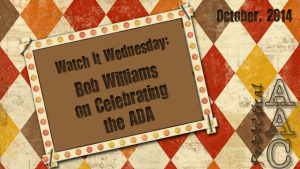
Nothing makes us happier than seeing people who use AAC be successful. Take a moment to watch this video of Bob Williams, who works for the federal government as a Ticket to Work Senior Advisor, celebrating.
Filed under: PrAACtical Thinking
Tagged With: ADA, Bob Williams









